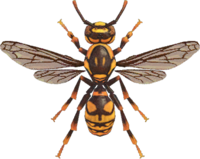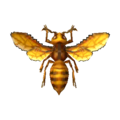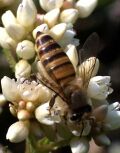Wasp
| ||||||||
 | ||||||||
| Real-world info | ||||||||
|---|---|---|---|---|---|---|---|---|
| Name: Unknown Family: Unknown | ||||||||
| Main appearances | ||||||||
|
| ||||||||
| Other appearances | ||||||||
Names in other languages
ハチ
벌 Vespa Wespe
黄蜂
Guêpe Avispa Wesp
黃蜂 Guêpe Avispa Оса | ||||||||
The wasp (known as the bee prior to New Horizons) is a bug in the Animal Crossing series that has appeared in every game to date. It can be found when shaking trees at any time of day or year. When shaken, a wasp nest can fall out of the tree, causing a swarm of wasps to chase the player. If the swarm reaches the player, they get stung.
Wasps will continue to chase the player as long as they are outside, until either they are caught or the player is stung. In New Horizons, the player can disperse a swarm of wasps by using a party popper. If the player speaks to a villager while being chase by wasps, the villager refuses to talk and tells the player to go away.
Getting stung by a wasp leaves the player with a swollen left eye, which can be healed by using medicine or, in games prior to New Horizons, saving and quitting. In New Horizons, getting stung again while the player already has a wasp sting results in them fainting and reappearing in front of their house.[nb 1] If the player speaks to a villager while having a wasp sting, the villager comments on it.
The wasp is one of three harmful bugs in the Animal Crossing series, alongside the tarantula and scorpion. If multiplayer is active or the player's gates are open, harmful bugs, including wasps, will not appear.
Catch details
In Animal Crossing
- "OWWWW! I got stung by a bee..."
- — The player after being stung by bees, Animal Crossing
In Wild World
- "I got stung by BEES! Ow! Ow ow ow ow!"
- — The player after being stung by bees, Animal Crossing: Wild World
| Description | These dangerous bugs are yellow and black. |
|---|---|
| Time of year | All year |
| Time of day | All day |
| Peak times | |
| Location | In trees |
| Bug size | 38 mm |
| Selling price | |
| Furniture size |
In City Folk
- "I got stung by a bee! Ow! Ow ow ow!"
- — The player after being stung by bees, Animal Crossing: City Folk
| Description | These poison-carrying bees will attack big foes to protect the queen. |
|---|---|
| Time of year | All year |
| Time of day | All day |
| Peak times | N/A |
| Location | Shaking trees |
| Bug size | 38 mm |
| Rarity | Rare |
| Selling price | |
| Furniture size |
In New Leaf
- "Ow! Ow ow ow... I got stung by bees!"
- — The player after being stung by bees, Animal Crossing: New Leaf
| Time of year | All year |
|---|---|
| Time of day | All day |
| Peak times | N/A |
| Location | Shaking trees |
| Size | 30 mm |
| Rarity | Rare |
| Selling price | |
| Furniture size |
In New Horizons
- "Ow! Ow ow ow... I got stung by wasps!"
- — The player after being stung by wasps, Animal Crossing: New Horizons
| Time of year | North: All year South: All year |
|---|---|
| Time of day | All day |
| Location | Shaking non-fruit hardwood trees or cedar trees |
| Weather | Any weather |
| Spawn requirement | Appears from the start of the game |
| Selling prices | |
| Furniture size |
Donating to the museum
In Animal Crossing
In Wild World
...I've recently heard that they also possess terribly replusive breath!
Of course, the gent who told me this was a bit of a rabit liar, but still! I would heartly endorse the following action if you see another: FLEE LIKE MAD! Stingers and bad breath, honestly! What monstrous little beasties..."In City Folk
The bee can be found flying from tree to tree along the back wall of the museum's insect exhibit.
In New Leaf
Upon being donated, the bee can be found in the room of the bug exhibit with the light in, flying around and resting on a tree in the back. The exhibit has this to say about the bee:
In New Horizons
Upon donating the wasp to the museum the curator, Blathers, will say the following:
Gallery
Real-world information
Prior to New Horizons
Apis cerana japonica, the Asiatic honey bee, is a hardy species of bee that originates from South-Eastern Asia. It is used commercially for its honey, despite having a smaller yield than its European counterpart, Apis mellifera. Mellifera has, however, been subject to selective breeding for many centuries, greatly increasing honey output over the years.
It is unknown whether the wasp in the Animal Crossing series is meant to be based on the Asiatic honey bee or Vespa mandarinia, the Japanese giant hornet, as the bee's Japanese name, hachi, can refer to both bees and wasps interchangeably. The bee's in-game design in Animal Crossing: City Folk and Animal Crossing: New Leaf is more similar to the Japanese giant hornet, and the beehives seen in-game bear closer resemblance to a hornet's nest than to a real-world honeycomb, while in Animal Crossing: New Horizons, the insect's design is closer to a European paper wasp, a species more widely recognized as a wasp rather than a bee outside of Japan.
In New Horizons
Polistes dominula, the European paper wasp, is a species of wasp that originates from Europe, North Africa, and southeast and eastern Asia. Like the Asiatic honey bee, the European paper wasp is a social species, congregating in large hives composed of numerous interlinked hexagonal cells similar to a honeycomb; rather than being made from natural wax, however, these hives are constructed of paper, created by chewing wood into pulp and spitting it out, hence the name "paper wasp." A special protein in the wasps' saliva toughens and waterproofs the pulp, allowing the hives to maintain shapes like that seen in the Animal Crossing series and ensuring greater protection from predators. Paper wasps are known to be more docile than other wasps, such as yellowjackets and hornets, and do not sting unless provoked or their nest is under threat.
Names in other languages
| ハチ Hachi |
Hymenopteran (can refer to bees, wasps, sawflies, etc.) | |
| 벌 Beol |
Wasp | |
| 黄蜂 Huángfēng |
Wasp | |
| 黃蜂 Unknown |
||
| Оса Osa |
Wasp | |
| Wesp | Wasp | |
| Wespe | Wasp | |
| Avispa | Wasp | |
| Guêpe | Wasp | |
| Vespa | Wasp | |
See also
Notes
| Bugs | ||||||||||||||||||||||||||
|---|---|---|---|---|---|---|---|---|---|---|---|---|---|---|---|---|---|---|---|---|---|---|---|---|---|---|
| ||||||||||||||||||||||||||









